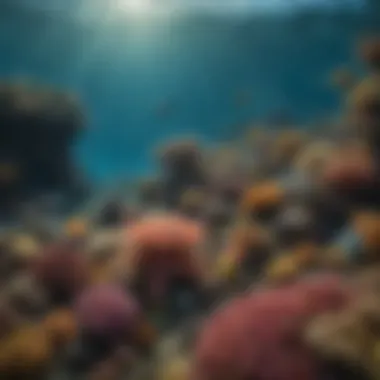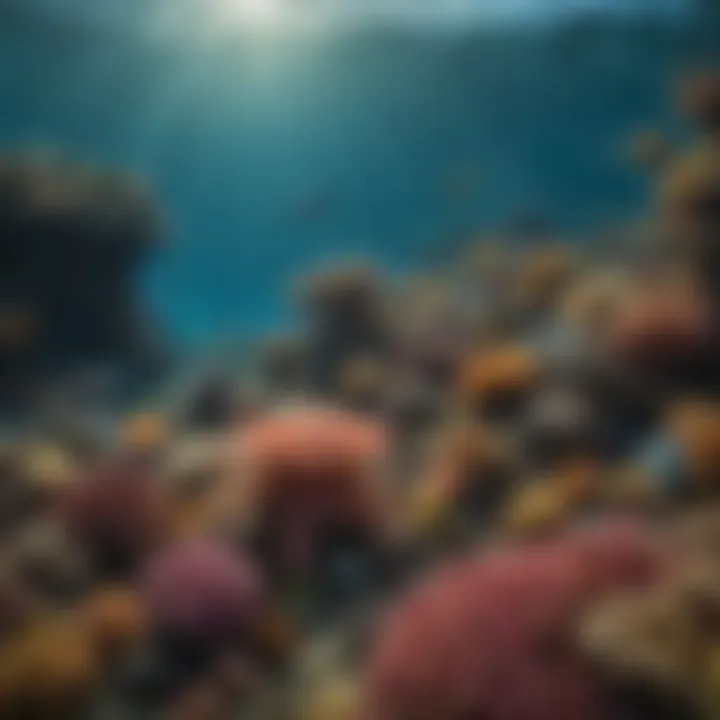Fascinating Insights into Ocean Ecosystems


Intro
The ocean is a swirling mass of mystery, harboring life forms and geological features that provoke both wonder and intrigue. While many might think they know the basics about this vast body of water, there’s so much more beneath the surface—literally and figuratively. It’s a landscape of extremes, from the sun-drenched shallows to the frigid depths of the abyss, each section of this watery realm offering a unique contribution to our planet’s health and diversity.
The ocean provides us with resources, regulates our climate, and serves as a vital component of Earth’s ecosystem. Yet, much like a hidden pearl within an oyster, many of its captivating aspects remain obscure. This article seeks to shed light on various elements that make the ocean not just a remarkable natural wonder, but also a crucial part of human existence.
Techniques and Skills
Understanding the intricacies of the ocean requires a blend of knowledge and skill—be it through exploration, conservation, or scientific research. There are essential techniques and advanced skills that can further one’s appreciation of marine environments.
Essential Techniques for Beginners
If you are just dipping your toes in the ocean's waters, here are a few key techniques to consider:
- Observation Skills: Learning to observe marine life requires patience. Whether you’re snorkeling or simply strolling along the shore, take note of colors, movements, and behaviors of the inhabitants around you.
- Surfacing Knowledge: Understand how tides, currents, and weather patterns affect marine life. This understanding can greatly enhance your interaction with the ocean.
- Safety Practices: Familiarize yourself with ocean safety, including understanding riptides and local wildlife. Knowing how to navigate these can’t be stressed enough.
Advanced Skills for Experienced Watersport Enthusiasts
For those well-versed in aquatic activities, delving deeper into advanced skills can elevate your experience:
- Navigation Techniques: Mastering the use of a compass and charts is crucial for longer sea adventures and can be the difference between a well-planned excursion and being lost at sea.
- Marine Ecology Understanding: Developing a deeper understanding of marine ecosystems, such as coral reefs or kelp forests, enhances not just your knowledge but also your responsibility towards preservation.
- Conservation Practices: Learn how to contribute actively to ocean conservation efforts, whether it’s participating in beach clean-ups or advocating for marine protected areas.
"The sea, once it casts its spell, holds one in its net of wonder forever." – Jacques Cousteau
Through these techniques and skills, we can foster a deeper appreciation for the ocean, ensuring that its wonders are not just seen, but celebrated responsibly. As we broaden our understanding, we not only empower ourselves but also harness knowledge that can inspire action for ocean preservation.
Equipment and Gear
Having the right equipment is crucial when engaging with the ocean's beauty and its challenges. Proper gear not only enhances experience but also ensures safety for all enthusiasts.
Must-Have Gear for Each Watersport
Each watersport comes with its own set of essential equipment:
- Snorkeling: A comfortable mask, snorkel and fins.
- Surfing: A suitable surfboard based on skill level and wave conditions.
- Diving: A wetsuit, buoyancy control device (BCD), dive computer, and regulator for safe underwater adventures.
Tips for Selecting the Right Equipment
When choosing your gear, consider the following tips:
- Quality Over Price: While budget-friendly options are tempting, investing in quality gear can be more economical in the long run—this reflects in performance and safety.
- Fit and Comfort: Make sure your gear fits properly. For example, a wetsuit that’s too tight can hinder movement and circulation.
- Research and Reviews: Utilize resources like Reddit and Facebook groups to gather opinions on equipment from those who’ve put it to the test.
Understanding the connection between the ocean and the equipment we use to explore it opens doors to more enriching encounters while encouraging responsible engagement with these vital ecosystems.
The Vastness of the Ocean
The ocean is not just a large body of water; it's a critical player in the Earth's environmental system. Its vastness affects weather patterns, regulates temperatures, and serves as a habitat for countless species. Understanding this dimension is essential in contextualizing our relationship with marine ecosystems. This section will explore the sheer scale of the ocean, shedding light on its size, depth, and distribution of water, all fundamental to grasping the ocean's influence.
The Size and Depth
When considering the ocean's size, think of it as something that stretches far beyond our everyday experiences. Covering about 71% of the Earth's surface, it contains 97% of the planet's water. The average depth of the ocean hovers around 12,080 feet, but areas like the Mariana Trench plunge down to an astounding 36,000 feet. To put that in perspective, if you were to drop Mount Everest down there, its peak would still be underwater!
Each square mile of ocean has its own stories to tell. Whether it's the temperate waters that cradle kelp forests or the darker depths that house enigmatic creatures, these regions are vital for biodiversity. The sheer volume of water impacts the global climate and is a critical component in the water cycle, affecting everything from rain patterns to sea levels.
"The ocean is a mighty harmonist." - William James
Distribution of Earth's Water
Not all water on Earth is created equal. The ocean accounts for approximately 97% of all the water on the planet. The remaining 3% is fresh water, which is primarily locked away in ice caps, glaciers, and underground aquifers. What's noteworthy is how this distribution influences life on land. A tiny fraction, around 0.3%, is accessible for our use in rivers and lakes.
This distribution raises critical concerns regarding water conservation and environmental sustainability. As populations grow, the demand for freshwater expands—leading to increased pressure on these limited resources. Simply put, the health of our oceans is inexorably linked to the health of fresh water systems.
In summary, acknowledging the vastness of the ocean helps ground our realization that it is not merely a resource but a life-sustaining entity. Its size, depth, and the distribution of Earth’s water shape not only the planet’s ecosystems but also the climate, human activity, and future sustainability. Understanding these aspects is crucial, especially for those involved in environmental advocacy, sports enthusiasts, and adventure seekers who often interact closely with these waters.
Oceanic Biodiversity
The ocean is a dazzling tapestry woven from an array of life forms and intricate ecosystems, making oceanic biodiversity a cornerstone of not just marine biology, but the very health of our planet. This section seeks to shine a light on the remarkable variety of species and habitats found beneath the surface, and the crucial roles they play in sustaining ecological balance. Biodiversity in the ocean means more than just different kinds of fish and coral; it encompasses the interconnections among organisms, their environments, and the crucial benefits they provide to human society.
Understanding oceanic biodiversity helps us appreciate not only the beauty of marine life but also the ecological functions that underpin the Earth's health. For instance, diverse marine ecosystems contribute to climate regulation, provide food, and offer medicinal resources that can lead to breakthroughs in healthcare. Each unique species plays a role in this complicated web, from the tiniest plankton that fuel the food chain to the massive blue whale that roams the depths. The ocean is a complex and dynamic world that is worth our attention and protection.
Species Diversity in Marine Ecosystems
Unique Habitats
Unique habitats in the ocean, such as deep-sea vents, coral reefs, and mangrove forests, are not just beautiful sights; they are crucial elements that help sustain life. Each habitat nurtures a different type of species and has distinct characteristics that support complex relationships among organisms. Coral reefs, for instance, support about 25% of all marine life despite covering only a fraction of the ocean floor. Their structure provides shelter and breeding grounds for numerous species, making them essential for marine biodiversity.
The adaptability of these habitats is noteworthy. They are often sensitive to changes, whether from natural phenomena or human activities. When we lose even a small portion of these ecosystems, it can send ripples through the entire marine environment. Thus, the preservation of unique ocean habitats is not just about saving pretty fish but rather about maintaining the entire biosphere that supports life.
Endemism


Endemism refers to species that are found nowhere else in the world, often adapted to specific environments. The unique current of River Amazon, for example, houses the Amazonian manatee, a gentle giant that plays a pivotal role in its ecosystem. These endemic species are vital to the idea of conservation because their existence is directly linked to the health of their native habitats.
Endemic species often thrive in isolation, leading to their evolution in extraordinary ways. However, this peculiarity makes them susceptible to extinction. An alteration in their immediate environment can lead to their rapid decline. Consequently, protecting these species and understanding their unique adaptations provide vital insights into the overall resilience of the ocean's ecosystems.
Invertebrates: The Dominant Ocean Dwellers
Jellyfish Lifecycles
Jellyfish may seem like simple creatures drifting through the ocean, but their lifecycles are surprisingly complex. From polyp to medusa, the transition is fundamental. This two-stage lifecycle plays a significant role in how jellyfish adapt to their environment, ensuring their survival.
The jellyfish bloom, where their populations suddenly surge, can indicate changes in ocean health, signaling overfishing or nutrient pollution. Such blooms can disrupt local fisheries and ecosystems. By studying these lifecycles, we can glean insights about the ecological status of our seas, making this a compelling topic in ocean research.
Coral Reefs
Coral reefs are often referred to as the "rainforests of the sea" for good reason. They are hubs of activity and biodiversity, housing thousands of marine species. A key feature of coral reefs is their ability to build intricate structures through the calcium carbonate they secrete, providing habitat and food for various life forms.
However, they face significant threats from climate change, ocean acidification, and pollution. The loss of coral reefs impacts not just marine biodiversity but also coastal protections and local economies reliant on fisheries and tourism. Keeping coral reefs thriving is essential for both marine life and human communities.
Ending
In summary, oceanic biodiversity is a delicate yet massive network of life that plays a fundamental role in the planet's ecological balance. Emphasizing the importance of unique habitats and endemic species reveals the intricate threads binding the ocean's ecosystems together. As we move forward, an appreciation for these aspects will help foster a sense of urgency in conservation efforts. By understanding our role within this larger system, we can work more effectively to protect the riches of the world's oceans.
Unusual Geological Features
The ocean is home to a plethora of fascinating geological formations, known collectively as unusual geological features. These natural wonders play crucial roles in marine ecosystems and influence global environmental conditions. Understanding these formations can enhance one's appreciation of the ocean and underscore its complexities and interconnectedness with the Earth’s climate and biodiversity.
Mid-Ocean Ridges
Mid-ocean ridges are impressive underwater mountain ranges formed by tectonic plate movements. As the plates pull apart, magma rises from the mantle, creating new oceanic crust. One striking feature of these ridges is the presence of hydrothermal vents, where superheated water rich in minerals is expelled into the cold ocean. This extreme environment gives rise to unique ecosystems that thrive without sunlight. The diverse organisms residing here, such as giant tube worms and chemosynthetic bacteria, are not only remarkable but also provide insight into potential life forms in other extreme environments across the universe.
- Key Points about Mid-Ocean Ridges:
- Formed by the divergence of tectonic plates
- Home to unique marine life
- Influence ocean circulation patterns and climate
"Mid-ocean ridges are the seams where new ocean floor is created, making them vital for the geological processes that shape the planet."
Deep-Sea Trenches
Deep-sea trenches are some of the most mysterious and profound areas of the ocean, plunging down into the abyss. The Mariana Trench, for example, reaches depths of over 36,000 feet, making it the deepest known point on Earth. These trenches form where tectonic plates collide, causing one plate to be forced below another in a process called subduction.
The extreme pressure and darkness in these trenches create a setting for unique adaptations among marine organisms. Species such as the giant squid and various deep-sea fish have evolved to survive in high-pressure environments, showcasing the wonders of evolution. The study of these trenches can also contribute to our understanding of biodiversity and the resilience of life.
- Characteristics of Deep-Sea Trenches:
- Extreme depths and pressure
- Unique ecosystems adapted to harsh conditions
- Potential for discovering new species and resources
Seamounts and Oceanic Volcanoes
Seamounts are underwater mountains formed by volcanic activity. They vary significantly in height and can be found throughout oceans, many still active. These geological features provide habitats for diverse marine life due to their nutrient-rich waters and unique structures. Coral reefs often develop around seamounts, supporting a myriad of species.
Oceanic volcanoes, while resembling their terrestrial counterparts, present different challenges and opportunities for research and exploration. Their eruptions can create new land masses and alter local ecosystems dramatically. Additionally, as these volcanoes erupt, they can release valuable minerals and metals, presenting both benefits and environmental concerns for marine communities.
- Significance of Seamounts and Oceanic Volcanoes:
- Important habitats for marine biodiversity
- Support for fishing industries due to rich resources
- Subjects of scientific study for understanding geological processes
In an era when ocean conservation is increasingly vital, recognizing the intrinsic value of these geological features can lead to more focused and effective protection measures. Each formation, from mid-ocean ridges to deep-sea trenches, contributes uniquely to the fabric of ocean life and the Earth's overall health.
The Ocean's Role in Climate
The ocean is not just a vast expanse of water; it holds a linchpin role in maintaining the Earth's climate. By absorbing, storing, and redistributing heat, the ocean acts like a gigantic thermostat, stabilizing weather patterns and influencing global temperatures. Understanding this role is essential for anyone interested in the intricate dance between the planet's ocean and climate systems.
Heat Distribution
The ocean covers more than 70% of the Earth's surface and plays a critical part in heat distribution. It absorbs about 90% of the excess heat generated by greenhouse gases. The mechanisms through which this heat is distributed are complex but can be explained simply through ocean currents.
- Surface Currents: These currents, driven by wind, move warm water toward the poles. Notable currents like the Gulf Stream transport warm water from the tropics to the North Atlantic, significantly affecting the climate in Western Europe.
- Deep Water Currents: Known as thermohaline circulation, these currents move colder, denser water from the poles back down towards the equator. This movement is crucial in regulating temperatures and ensuring heat is balanced across the globe.
Through this heat redistribution, the ocean helps maintain a stable climate, preventing extreme temperature variations. As climate change continues to disrupt these currents, the implications for weather patterns are profound. Researchers observed shifts in these currents, which may lead to altered rainfall patterns and increased storm intensity.
Carbon Dioxide Absorption
The ocean is frequently referred to as the planet's lungs, as it absorbs vast amounts of carbon dioxide. Approximately 30% of this gas produced by human activities is absorbed by oceans. This capability is vital but comes with notable considerations.
- Maintaining Balance: By absorbing CO2, the ocean helps mitigate the greenhouse effect. However, this also leads to ocean acidification. A decrease in pH levels can seriously impact marine life, particularly organisms with calcium carbonate shells, such as coral and some shellfish.
- Biological Pump: The ocean's ability to sequester carbon is also aided by marine organisms. Phytoplankton, for instance, absorb CO2 during photosynthesis. When they die, their bodies sink to the ocean floor, effectively removing carbon from the atmosphere for potentially thousands of years.
"Without the ocean’s absorption of carbon dioxide, the effects of global warming would be magnified, leading to catastrophic climatic events."
The ocean’s dual role in heat and carbon management illustrates the interconnectedness of Earth’s systems. For sports enthusiasts, adventure seekers, and coaches, understanding these dynamics could also highlight the importance of conservation efforts—sustaining the ocean means sustaining our climate and, ultimately, our way of life.
Human Impact on the Ocean


As stewards of the planet, our interaction with the ocean is critical, not just for our survival, but for the health of marine ecosystems. Oceans cover more than 70% of Earth’s surface. Understanding how human actions affect such a grand entity can shed light on urgent conservation needs. Here we take a closer look at the detrimental effects and the responsibility we bear in rehabilitating these vital bodies of water.
Pollution and Its Consequences
Plastic Pollution
Plastic pollution is often hailed as one of the most pressing issues our oceans face today. With an estimated 8 million tons of plastic entering marine environments each year, this problem is like an unrelenting tide washing over fragile ecosystems. A significant characteristic of plastic is its durability; while it can last for hundreds of years, the breakdown of plastic products into microplastics poses unique challenges.
The widespread use of plastics is due to their practical benefits—they are lightweight, cheap, and versatile. However, it's precisely these characteristics that have turned them into a liability. Once in the ocean, plastic doesn't just vanish; it affects marine life and ultimately makes its way into the food chain.
- Key Features of Plastic Pollution:
- High resistance to degradation
- Potential to absorb harmful pollutants
These factors render plastic pollution not just an eyesore on beaches but a severe health risk for marine species and humans alike. Fish ingesting microplastics can lead to significant health implications for consumers. The overarching idea is that addressing this issue is crucial for maintaining biodiversity and, ultimately, human health.
Chemical Contaminants
Chemical contaminants represent another facet of pollution that warrants our serious attention. Pesticides, heavy metals, and industrial waste are common pollutants finding their way into ocean waters. These substances often accumulate in the fatty tissues of marine life, creating toxic effects that reverberate through the entire food web.
The persistence of chemical contaminants makes them especially concerning. Their effects are often gradual, impacting not just marine flora and fauna but also human health over time. For example, mercury contamination from industrial effluents poses a grave risk to species like tuna, which are consumed widely.
- Key Characteristics of Chemical Contaminants:
- Capability to bioaccumulate in organisms
- Long-term effects on ecosystems and human health
The unique danger lies in their silent, pervasive nature. Contaminated seafood can lead to serious health issues such as neurological damage, emphasizing the need for stringent regulations and a commitment to reducing chemical inputs into marine environments.
Overfishing and Marine Life Depletion
Overfishing has reached alarming levels, contributing to a significant decline in various fish populations. This does not only threaten the aesthetic variety of our oceans but also disturbs the delicate balance of marine ecosystems. Species such as cod and tuna have seen their numbers plummet, making it harder for these fish to recover.
The practice of overfishing often goes hand in hand with other destructive methods, such as bottom trawling, which devastates habitats. As larger fish become depleted, the entire marine food web is thrown into disarray, impacting smaller fish and other organisms that rely on them.
Moreover, the economic implications are significant. Nations heavily dependent on fishing industries face repercussions not just environmentally but also economically. The fish supply chain collapses, leading to job losses and weakened local economies.
In sum, the impact of human activity on the ocean is profound, from pollution that chokes marine life to the consequences of overfishing that disrupts ecosystems. A better understanding of these issues is vital for fostering conservation efforts and ensuring the health of our oceans for future generations.
Ocean Exploration
Exploring the ocean is like peeling back the layers of a massive onion; each layer offers something new and sometimes surprising. The ocean covers over 70% of our planet, yet much of it remains largely uncharted and unexplored. Ocean exploration is crucial not only for understanding our planet better but also for making informed decisions regarding conservation and resource management. By diving into the depths of this vast body of water and using advanced technologies, we can unlock secrets that have been hidden for millennia.
One key element that stands out in the discussion of ocean exploration is its potential for scientific breakthroughs. From discovering new species to understanding ecological systems, every expedition can yield valuable knowledge about marine environments. The benefits are manifold; for instance, the insights gained can assist in climate change research, biotechnology, and even medicine.
Technological Advancements
Remote Sensing
Remote sensing plays a pivotal role in modern ocean exploration. This technology employs satellites and aerial sensors to collect data about the ocean’s surface. One standout characteristic of remote sensing is its ability to cover vast distances, providing valuable information on sea surface temperatures, chlorophyll levels, and even wave patterns.
This makes it a popular choice for marine biologists and ecologists alike, as it allows them to gather data without needing to be physically present. With the unique feature of enabling researchers to capture large-scale data quickly, remote sensing becomes indispensable.
However, it does have its limitations. While it provides great snapshots of surface conditions, remote sensing cannot offer deep insights into underwater ecosystems where many complexities lie hidden. Thus, it serves more as a complementary tool rather than a standalone solution.
Submersibles
When it comes to exploring the depths, submersibles take center stage. These specialized vehicles are designed to withstand the immense pressures of the deep sea and are equipped to capture data in real-time. One of the most noteworthy aspects of submersibles is their ability to take humans into environments previously deemed inaccessible, thus providing firsthand observational opportunities.
Submersibles are a beneficial choice for exploring marine life bio-diversity and geological features like hydrothermal vents. Their unique feature lies in their capacity to reach depths beyond the reach of traditional research vessels, making them essential tools in many expeditions.
A disadvantage is the high cost associated with deploying submersibles, and often, they can only be used intermittently due to the technical demands of operating in such extreme conditions. Regardless, the invaluable data they provide often outweighs these challenges, affording researchers insights that might otherwise remain hidden.
Uncharted Areas
The ocean’s uncharted waters hold a treasure trove of mysteries waiting to be uncovered. These areas are not just devoid of maps; they are likely habitats for entire ecosystems that have evolved in isolation. While technology has made leaps in exploring these depths, a significant portion still remains a black hole in our planetary knowledge.
Exploring these uncharted areas can reveal:
- New Species: Many organisms may inhabit these unnoticed realms, offering insights into biodiversity that science has yet to catalogue.
- Medicinal Resources: Some marine species have unique chemical compounds that could lead to breakthroughs in pharmaceuticals.
- Geological Secrets: Mapping the seafloor may reveal underwater volcanoes or tectonic plate interactions that contribute to our understanding of Earth's geology.
"Much of the ocean is still a mystery. The deeper we explore, the more we learn just how little we know."
In summary, ocean exploration is an increasingly vital field that combines technology, scientific inquiry, and environmental stewardship. By utilizing advancements such as remote sensing and submersibles, researchers are uncovering uncharted areas that could be crucial for future conservation efforts.
Marine Life Adaptations
Marine life has evolved in ways that often seem like magic, showcasing the incredible adaptability of organisms within the ocean. Understanding these adaptations is important, as they highlight how diverse creatures harness the unique challenges posed by their environments. Whether it's the deep dark abyss or vibrant coral reefs, the ocean is filled with life that learns to thrive through remarkable survival strategies.
Bioluminescence
Bioluminescence is one of the most astonishing adaptations in the marine world. Some creatures, like the anglerfish and certain jellyfish, can produce light through biochemical reactions. This phenomenon serves various purposes. For example, the anglerfish uses its glow to lure unsuspecting prey, while others might flash their lights as a warning signal to predators or as a means of communication within their species.


"In the pitch-black depths of the ocean, bioluminescence acts as a flashlight guiding various forms of life, illuminating their existence".
The role of bioluminescence stretches beyond survival; it is critical for ecosystem dynamics. It affects predator-prey relationships and contributes to nutrient cycling in the ocean, showing how delicate balances are maintained within this vast blue expanse. Furthermore, studying bioluminescent organisms can lead to advancements in science and medicine, such as the development of luminescent markers used in research.
Extreme Environment Survivors
In addition to bioluminescence, many marine organisms have evolved traits that allow them to endure extreme environments, such as hydrothermal vents or freezing polar waters. Take the extremophiles thriving near hydrothermal vents, for example; these creatures withstand high temperatures and pressure that would obliterate most forms of life.
Organisms like giant tube worms and certain types of bacteria can survive by utilizing chemosynthesis, a process that harnesses the chemical energy of molecules like hydrogen sulfide. This ability highlights the strength of life to adapt and flourish, even in seemingly inhospitable conditions.
Similarly, polychaete worms and some Arctic fish have developed antifreeze proteins to survive subzero temperatures, ensuring their survival during harsh winters. These adaptations are not mere anomalies; rather, they are a demonstration of life's resilience and the innovative ways marine life has learned to navigate its environment.
Understanding how these adaptations work is essential for appreciating the ocean's complexity and vulnerability. It sparks curiosity about unsolved mysteries, such as how human activities might threaten these bizarre yet crucial survival strategies.
Ocean Myths and Misconceptions
Understanding the myths surrounding the ocean is not just trivia; it is essential for fostering a more informed approach to marine conservation and appreciation. Many misconceptions can affect public perception and policy-making regarding ocean ethics and sustainability. A clearer grasp of the realities of our oceans influences how we engage with and protect these vital ecosystems, nurturing respect and stewardship among adventurers, educators, and recreational enthusiasts alike.
The Truth About Sharks
Sharks often get a bad rap in popular culture, painted as man-eating monsters lurking beneath the waves. The truth, however, is that sharks are more often misunderstood than they are malevolent. In fact, they play a crucial role in maintaining the balance of marine ecosystems. By preying on the weak and sick, sharks help keep populations of fish healthy, which in turn supports the overall health of the ocean.
"Sharks are our ocean's environmental stewards. Their absence can lead to overpopulation and ecological collapse."
Moreover, the dangers posed by sharks are frequently exaggerated. Statistically, the likelihood of being bitten by a shark is incredibly low. For instance, according to the International Shark Attack File, you are more likely to be struck by lightning than bitten by a shark. Initiatives aimed at demystifying these usually misunderstood creatures have been gaining momentum. Promoting accurate portrayals can spark interest and inspire respect for these magnificent beings.
Understanding Whales
Whales, too, come candy-coated with mythology. Often imagined as gentle giants, the realities underlying their behaviors and communication are far more intricate. These mammals engage in complex relationships and social structures. For example, orcas, usually labeled as 'killer whales,' vastly differ from the savage predators one might visualize. They display sophisticated hunting techniques and familial bonds, making them a fascinating study in social behavior.
The notion that all whales migrate is also misleading. While many species do undertake epic journeys across oceans, some are resident species that inhabit specific regions throughout their lives. This variance in behavior reflects their adaptability to different environments, which deserves recognition.
In summary, realizing that the narratives surrounding whales and sharks stem from a combination of facts and fiction helps cultivate greater respect for marine animals. As we elucidate these misunderstandings, our connection with the ocean deepens, encouraging both empathy and conservation.
Ocean Literacy and Education
Understanding the ocean and its intricacies is essential not just for scientists but for everyone who calls Earth home. Ocean literacy encompasses the comprehension of the ocean's influence on people's lives, as well as the recognition of human impact on these vital ecosystems.
Importance of Ocean Awareness
Awareness around ocean issues is crucial today more than ever. The ocean is not just a blue expanse; it plays a significant role in climate regulation, weather patterns, and biodiversity. By understanding how the ocean operates, individuals can grasp its connection to various aspects of life. This knowledge allows for informed decision-making in our daily activities, whether it’s reducing plastic usage or supporting sustainable seafood
Key elements of ocean awareness include:
- Climate Change: The ocean absorbs a significant portion of greenhouse gases. Knowing this helps us appreciate the ocean's contribution to climate stability and the need to protect it.
- Biodiversity: With thousands of species, from the tiniest planktons to the largest whales, ocean biodiversity is crucial. Understanding these connections highlights the importance of habitats such as coral reefs and mangroves.
- Human Health: The ocean provides food, recreation, and economic benefits. Awareness can lead to healthier lifestyles and ecosystems.
By weaving ocean literacy into education systems at every level, we can foster a generation that appreciates and actively participates in its stewardship.
Promoting Conservation Efforts
Promoting conservation is not merely an activity for environmentalists; it’s a community affair. Schools, local governments and organizations increasingly recognize the value of integrating ocean conservation into their agendas.
Effective conservation efforts can take many forms. Some may include:
- Hands-On Learning: Organizing beach clean-ups or snorkeling events engages communities, turning abstract concepts into tangible experiences. This connection encourages stewardship, demonstrating that small efforts can come together for significant change.
- Local Policies: Supporting legislation that protects marine habitats and species can profoundly affect the health of our oceans. Advocating for policies that promote responsible fishing and habitat preservation is key.
- Public Awareness Campaigns: Utilizing social media channels, like Facebook or Reddit, involves the public in ongoing discussions about ocean-related issues. Providing clear, digestible information can encourage even those who consider themselves non-academic to participate in the conversation.
"To preserve the ocean is to preserve life itself; it would be foolish to let ignorance erode its gifts to humanity."
By understanding the ocean and advocating for its conservation, we can forge a path toward a sustainable future, not just for marine life, but for ourselves and the generations to come.
Future of Ocean Conservation
The future of ocean conservation is an essential theme that touches not just marine biology or ecology, but also societal values, economic interests, and our very survival on this planet. The world's oceans cover over 70% of the Earth's surface and influence global climate patterns, making their health critically important. A comprehensive approach to ocean conservation acknowledges the delicate interplay between ecosystems and human actions, urging a collective commitment to safeguarding marine environments for the generations to come.
One of the fundamental aspects of this topic is the realization that ocean health directly affects human health. Whether it's the air we breathe or the food we eat, our lives are intertwined with the ocean's well-being. By prioritizing conservation efforts, we not only protect biodiversity but also preserve critical resources, thereby contributing to food security and economic stability.
"Healthy oceans are vital for a balanced ecosystem, sustaining diverse marine life and supporting human activities alike."
Innovative Policies
Innovative policies play a key role in shaping the future of ocean conservation. Policymakers are increasingly recognizing the need for integrating science into decision-making processes. This may involve establishing marine protected areas where human activity is restricted, thereby allowing ecosystems to recover and thrive. Such policies can help mitigate the harmful effects of overfishing, habitat destruction, and pollution.
Consideration of the economic aspects is pivotal in developing these policies. For instance, implementing sustainable fishing practices provides long-term benefits by allowing fish populations to replenish. Additionally, the promotion of eco-tourism can serve as an alternative livelihood for coastal communities, reducing reliance on destructive practices.
- Key areas for innovative policies include:
- Marine Protected Areas (MPAs): Safeguarding high biodiversity zones.
- Sustainable Fishing Regulations: Ensuring fish populations remain viable.
- Pollution Controls: Reducing plastics and chemical runoff.
Community Involvement
Community involvement is the backbone of any successful ocean conservation initiative. Local communities often possess invaluable knowledge about their marine environments and the challenges they face. Engaging them not only raises awareness but also fosters a sense of ownership, which is critical in building a conservation ethic.
Education plays a fundamental role here. Schools and local organizations can promote programs that teach about marine biology and conservation practices. These initiatives can inspire the next generation to advocate for sustainable practices and lead by example.
A few strategies for boosting community involvement include:
- Organizing clean-up drives: Encouraging local residents to clean beaches and coastal areas.
- Involving indigenous communities: Recognizing and incorporating traditional ecological knowledge in conservation strategies.
- Creating volunteer programs: Offering opportunities for local stakeholders to participate in research and conservation activities.







